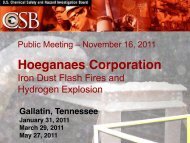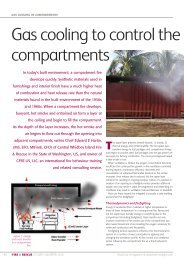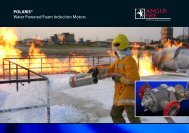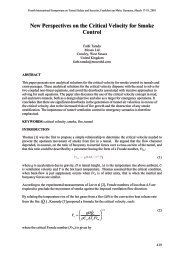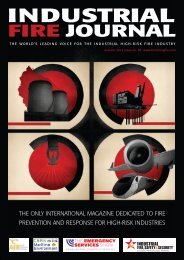aboard FPSO.pdf - Industrial Fire Journal
aboard FPSO.pdf - Industrial Fire Journal
aboard FPSO.pdf - Industrial Fire Journal
Create successful ePaper yourself
Turn your PDF publications into a flip-book with our unique Google optimized e-Paper software.
<strong>FPSO</strong> – PASSIVE SAFETY<br />
All <strong>aboard</strong> <strong>FPSO</strong> safety<br />
Floating production storage and offloading (<strong>FPSO</strong>) units<br />
and other offshore assets require critical firewater to be<br />
readily available at a moment’s notice – but how to<br />
ensure fire systems and piping are not adversely<br />
affected by the challenging environments they are<br />
expected to work in? Jose Sanchez de Muniain looks at<br />
the latest in fire water protection solutions as well as<br />
Allan Beeston,<br />
Global Manager<br />
(<strong>Fire</strong> Protection) for<br />
Morgan Thermal<br />
Ceramics’ range of<br />
<strong>Fire</strong>Master<br />
products.<br />
<strong>Fire</strong>Master 607 is<br />
popular because it<br />
can be easily<br />
installed and<br />
removed –<br />
depending on the<br />
jacketing system<br />
used – with no<br />
welding.<br />
more established systems.<br />
Flexible piping for critical firewater<br />
The Elastopipe project began in 1996 as a collaboration between<br />
Swedish company Trelleborg and a number of industry stakeholders<br />
(Conoco-Phillips, Norsk Hydro, BP Amoco, Statoil amongst others)<br />
and Royal Norwegian Navy Material Command.<br />
These stakeholders had noted the launch in 1990 of a jet-fire<br />
resistant rubber compound by Trelleborg. Hans-Leo Hals, Elastopipe<br />
Group Product Manager, explains more: “They wanted to see a<br />
non-corrosive system that could also withstand both high impact<br />
and jet fires. They already knew we had <strong>Fire</strong>stop (technology<br />
providing blast-proof, passive fire protection of structures and<br />
equipment), so the question was, could it be used to coat existing<br />
materials, or could we develop a new type of solution?” The answer<br />
was a resounding yes, and since its commercialisation in 1998 ,<br />
Elastopipe systems have been installed in six offshore locations for<br />
companies that include BP Amoco, Statoil and Conoco-Phillips.<br />
So what makes Elastopipe special? Three layers make up the<br />
non-corrosive, rubber-like Elastopipe – an outer fire shield, middle<br />
pressure liner, and inner layer. The outer layer provides the jet-fire<br />
resistance, and it can resist a heat flux of 390kW/m 2 , as well as<br />
temperatures above 1,350°C and flame speeds above the speed<br />
of sound, for an impressive one hour, with no water in the pipe for<br />
the first five minutes.<br />
It also has a high impact resistance, and when struck it behaves<br />
similarly to a car tyre – first it bends and then it goes back to its<br />
original shape. “That means that even after impact it will transport<br />
the liquid inside it,” explains Hals. In fact, the system can maintain<br />
burst pressure following a collision force of up to 800J. It can also<br />
tolerate an explosive overpressure pulse of 1.5 bar and 200 ms<br />
duration. But perhaps what makes this solution unique in the<br />
market is its corrosion-free properties. Hals points out that in some<br />
areas of the world traditional water deluge systems incorporating<br />
stainless steel pipes can suffer significant degradation in as little as<br />
two years – which can result in expensive refurbishment or even<br />
replacement programmes. “In Australia for example you have high<br />
temperature and humidity, so all the ingredients for corrosion are<br />
there. In other areas marine growth can close up nozzles within<br />
months.” In locations such as these, high levels of maintenance and<br />
repair not only add significant costs, but also – importantly – they<br />
can interrupt production. “Traditional steel piping requires hot-work<br />
on site which naturally has an impact on normal operations.” This<br />
isn’t the case with Elastopipe, which requires no hot-work and – in<br />
the case of a refurbishment – little if any disruption.<br />
The maintenance-free side of the Elastopipe system is important<br />
not only in the context of traditional piping for critical water, but also<br />
in the context of the latest generation of oil and gas exploration. The<br />
expected lifetime of offshore assets used to be in the region of 20<br />
years – no longer, points out Hals. “New technology is allowing<br />
operators to dig deeper and we are finding in the oil industry that<br />
the lifetime of assets is increasing to 30 years – in some regions<br />
there is demand for 40 years. We are now currently working on a<br />
lifetime version of 40 years.”<br />
Elastopipe FOR (fire and oil resistant) is the latest version of the<br />
Elastopipe family. As its name suggests, as well as being jet-fire<br />
resistant, the new version of the synthetic rubber-based flexible<br />
piping system can transport organic materials without degrading.<br />
The latest development incorporates a polymer-based lining<br />
material with high resistance against degradation by hydrocarbons<br />
(lifetime of 30 years). Offering weight advantages over conventional<br />
steel the Elastopipe FOR is suitable for H2S ventilation lines,<br />
produced water (water mixed with oil), open and closed drains, and<br />
waste lines.<br />
Ceramic protection<br />
Family-owned Norwegian company Favuseal AS has been supplying<br />
glass-reinforced epoxy (GRE) piping protection since the invention<br />
of the Favuseal <strong>Fire</strong> Barrier System (FFBS) in 1988.<br />
Favuseal is a thermoplastic compound with extraordinary<br />
properties when subjected to high temperatures. It consists of<br />
mineral fillers inside a thermoplastic “matrix” which is wrapped<br />
around the relevant piping. When subjected to high temperatures<br />
FFBS goes through two phases. Firstly, in the temperature range<br />
200-250 °C, it generates crystal water during an endothermic (heat<br />
absorbing) reaction which prevents the temperature rising further<br />
until the complete release of H 2 O. During the second phase –<br />
which occurs between 700-800°C – the minerals in the fillers<br />
oxidise and form a cellular ceramic material that is glass-like and has<br />
very low thermal conductivity (0.07 W/m°K). The ceramic material<br />
is physically stable in temperatures of up to 1,500 °C, and will<br />
provide 15 minutes of protection with a 5mm layer of Favuseal,<br />
and 30 minutes with 10mm during a violent jetfire – and this is<br />
with dry pipes as opposed to water-filled pipes.<br />
46 ❘ INDUSTRIAL FIRE JOURNAL ❘ FIRST QUARTER 2011 Read our magazine at www.hemmingfire.com
Erik Schlytter-Henrichsen of Favuseal explains that FFBS is often<br />
used to protect the steel and GRE piping in water deluge systems:<br />
“You cannot have a fire protection system containing water due to<br />
the risk of corrosion/contamination and subsequent risk of nonfunctioning<br />
nozzles due to corrosion and foreign contamination. So<br />
the challenge is to keep the pipes' temperature low enough until<br />
the water arrives. So Favuseal buys the system time enough to do<br />
its job.” One of the main benefits of Favuseal is that no hazardous<br />
emissions are created when the system is active: “This makes it<br />
possible for responders to tackle the fire with no risk of inhaling<br />
toxic gases,” explains Erik.<br />
Today the company has installations in South Korea (offshore<br />
and onshore), Middle East, the Netherlands (oil and gas GRE pipes<br />
onshore), Denmark, Norway (cooling systems and firefighting<br />
waterpipes), and a major cable manufacturer is using Favuseal to<br />
protect cables in the North Sea and all over the world.<br />
Traditional solutions<br />
Allan Beeston is Global Manager (<strong>Fire</strong> Protection) for Morgan<br />
Thermal Ceramics’ (previously Thermal Ceramics) range of<br />
<strong>Fire</strong>Master products. Thermal Ceramics, headquartered near<br />
Liverpool in the UK, is part of the Morgan Crucible group.<br />
The <strong>Fire</strong>Master fire insulation solution was especially formulated<br />
in the 80s as a lightweight solution against hydrocarbon and jet<br />
fires, and today it is used in various process and fire protection<br />
solutions both onshore and offshore. Key offshore references for<br />
fire pipe protection include Conoco Sanah, Sevan Marine No4,<br />
Sevan Marine 300 No5, Ningaloo Vision, and Marathon Alvheim.<br />
<strong>Fire</strong>Master is a non-combustible flexible matt manufactured from<br />
low biopersistence alkaline earth silicate fibres exonerated from<br />
classification as a carcinogenic material under EU health regulations<br />
Elastopipe projects –<br />
new-builds and refurbishments<br />
In August 2008, <strong>FPSO</strong> Sevan Hummingbird<br />
became the first cylindrical <strong>FPSO</strong> to be<br />
installed in the North Sea. <strong>FPSO</strong> owner<br />
Sevan Marine decided to install Elastopipe<br />
for a number of reasons – not least of which<br />
was the material’s corrosion-free properties.<br />
While the original specification for steel<br />
piping calls for system tests every three<br />
months, Elastopipe’s properties mean that<br />
testing is only required every 24 months –<br />
and this only due to the limiting factor of<br />
peripheral materials.<br />
The fact that no welding or metal cutting is<br />
required for Elastopipe installation meant that no disruptions due to hot work were necessary for<br />
the rest of the <strong>FPSO</strong> Sevan Hummingbird’s installers.<br />
Elastopipe is also experiencing increased take up for major refurbishments of existing stainless<br />
steel fire deluge systems. One such replacement occurred between 2003-2006 on Statoil Hydro’s<br />
Oseberg, which was experiencing corroding welds and pressure leaks. A specifically designed<br />
system was completed by Trelleborg with Aibel Engineering, comprising of 13,000 metres of<br />
Elastopipe, which was installed in a straight one-to-one replacement. Again, no welding or metal<br />
cutting was required.<br />
Hans-Leo Hals of Trelleborg says that with the exception of the Gulf of Mexico, Elastopipe now has<br />
a worldwide presence – not yet the standard of choice on offshore locations but, says Hals,<br />
certainly a material of choice. “It has been time-consuming to certify this type of product because<br />
it is not a standard material, such as steel. However, we have received approval for Elastopipe<br />
installations on a case-by-case basis and hope that it will become a standard material.”<br />
Read our magazine at www.hemmingfire.com FIRST QUARTER 2011 ❘ INDUSTRIAL FIRE JOURNAL ❘ 47
<strong>FPSO</strong> – PASSIVE SAFETY<br />
The Favuseal <strong>Fire</strong><br />
Barrier System has<br />
been used to<br />
protect fibre<br />
reinforced epoxy<br />
(as above) and<br />
steel piping<br />
since 1988.<br />
for man-made fibres. Its fire protection properties are impressive<br />
and fire tests, explains Allan, have proven performance of the<br />
<strong>Fire</strong>Master 607 for up to four hours in hydrocarbon fires and one<br />
hour in jet fires. “It is a common solution for <strong>FPSO</strong> units where<br />
basically process equipment is fire proofed using some kind of<br />
jacketing system – usually a flexible jacket. Commonly there are<br />
many suppliers with different jacketing designs but with a<br />
<strong>Fire</strong>Master core.” What makes it popular is that as a dry, passive<br />
material it can be easily installed and removed, depending on the<br />
jacketing system used, with no welding required.<br />
With the <strong>Fire</strong>Master providing the thermal protection, the main<br />
consideration revolves around weather protection and how well the<br />
system is maintained. “In Norway for example there is a standard<br />
approach which consists of a combination of materials that is<br />
slightly different to the norm. NORSOK standards (formed by the<br />
Norwegian petroleum industry with support from the Norwegian Oil<br />
Industry Association) stipulates foamglass on the pipes, with a layer<br />
of <strong>Fire</strong>Master, and then on top stainless steel cladding. This makes<br />
the system weather-proof, while the foamglass as a closed cell<br />
material doesn't allow water to get through to the pipe.”<br />
There is currently no clear winner as regards jacketing<br />
technologies vs steel cladding, even with the NORSOK (Norwegian<br />
petroleum industry association) preference for steel cladding.<br />
“Flexible jackets were all the rage 10 years ago, but even with the<br />
Norwegian approach in the last few projects I've seen our clients<br />
have used flexible jackets, so it isn't easy to say.” As for the future,<br />
Allan is unsure that there will be any revolutionary developments in<br />
passive fire protection in this field. Thinner solutions with better<br />
jacketing, perhaps, but jet fires require a robust approach: “There is<br />
nanotechnology floating around out there, and we've seen it for<br />
thermal insulation, but it struggles to meet the temperature<br />
requirements of jet fires of 1,100-1,300°C.”<br />
Aerial <strong>Fire</strong>fighting<br />
Conference &<br />
Exhibition<br />
23rd - 24th March 2011<br />
Washington DC<br />
USA<br />
Draeger’s new products<br />
Draeger has launched new product ranges ideally suited to a wide range<br />
of industrial applications requiring extended duration of breathing air and<br />
highly sophisticated body protection, in combination with light and<br />
functional breathing protection.<br />
Applications range from shut-down management in power stations,<br />
petrochemical plants and oil refineries, and confined space entry in all<br />
industries; to land based systems for the armed forces and<br />
decontamination for fire brigades.<br />
The Draeger PAS MAC series of medium pressure breathing air<br />
compressors is setting new standards in mobile long duration life support<br />
systems.<br />
The new range of fully standards-compliant compressors are designed for<br />
use in the most severe of environments, and are available in four size<br />
outputs varying from 185 l/min to 1710 l/min, supplied with either electric<br />
or diesel drive (electric versions also available ATEX zone 1-compliant).<br />
New too is a limited-use chemical protective suit – the Draeger CPS 5800<br />
– which provides protection from gaseous, liquid or solid hazardous<br />
substances in a large range of industrial applications and operations on<br />
board.<br />
The suit meets the highest international requirements of industry, fire<br />
departments and shipping, such as EN 943-1+2:2002 and SOLAS II-2, Reg.<br />
19 (pending).<br />
The Draeger CPS 5800 is made from high quality material (Zytron 500)<br />
resulting in a service life of up to 10 years and with the proven design of<br />
the Draeger WorkMaster pro ET, this suit is very comfortable to wear and<br />
is equipped with the flexible Draeger face cuff.<br />
For breathing protection there is a brand new SCBA that has been tailormade<br />
for industrial and shipping applications.<br />
The Draeger PAS Lite's main benefits revolve around low maintenance,<br />
robustness, and low weight.<br />
It is also approved to the latest requirements of EN137:2006 type II, which<br />
includes the extended flame retardancy requirements for the materials as<br />
required for firefighting use.<br />
Moreover, all versions of the PAS Lite carry the MED ships' wheel mark<br />
which means the equipment is suitable for use on board ships, whilst<br />
passing the mechanical requirements of ATEX, making the equipment<br />
suitable for use in explosive (Zone 0) atmospheres.<br />
Applications for the PAS Lite range from emergency use "wall hanger" on<br />
ships, to day-long airline use on petrochemical plants or utilities process<br />
working.<br />
According to Draeger, the PAS Lite is ideally suited to all industrial and<br />
shipping applications where a simple-to-use, robust and easy-to-clean<br />
SCBA is required.<br />
The PAS Lite is available with ChargeAir connections – especially useful in<br />
petrochemical industries and mining where the facility to rapid charge the<br />
breathing air cylinder is important in emergency situations.<br />
In addition, the system is certified to the latest airline standard EN14593-1<br />
when fitted with the Draeger PAS ASV, allowing seamless integration into<br />
the airline system portfolio.<br />
STRATEGIC SPONSOR<br />
SUPPORTING MEDIA<br />
Tel: +44(0) 1628 660400 www.tangentlink.com<br />
48 ❘ INDUSTRIAL FIRE JOURNAL ❘ FIRST QUARTER 2011 Read our magazine at www.hemmingfire.com


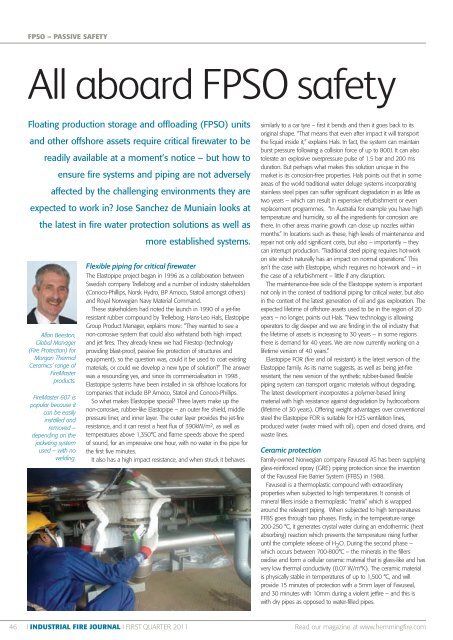
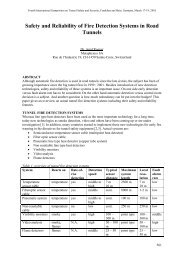
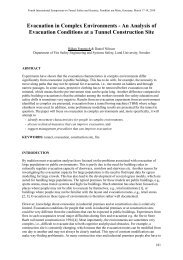

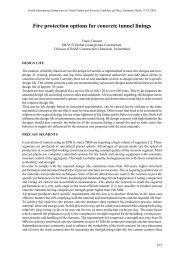
![30-37 TunnelsREV[1]rev.qxd - Industrial Fire Journal](https://img.yumpu.com/22237435/1/184x260/30-37-tunnelsrev1revqxd-industrial-fire-journal.jpg?quality=85)
